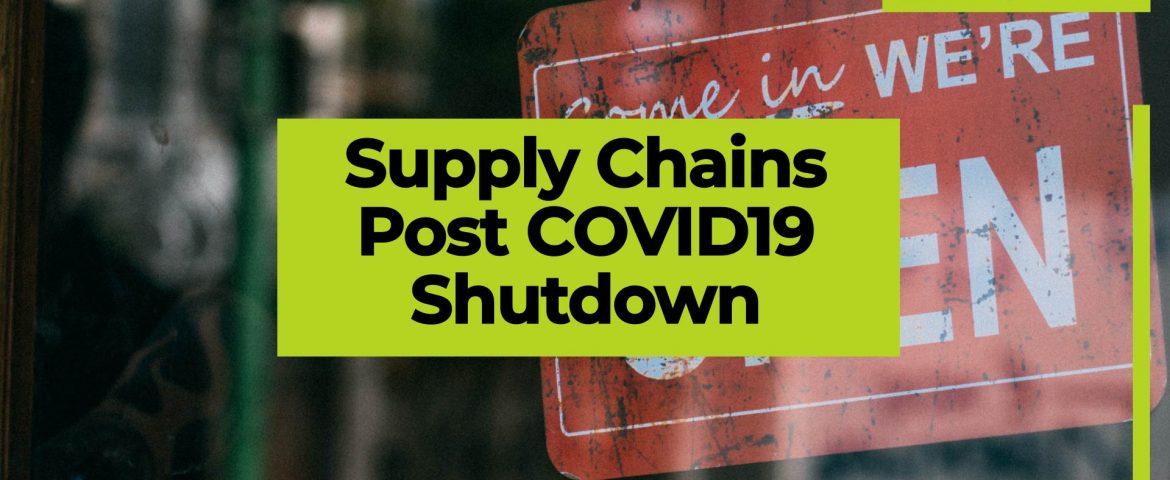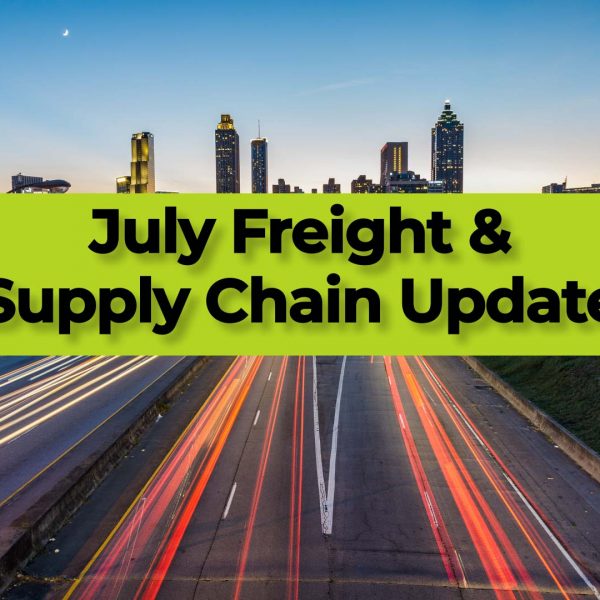State of Supply Chains after COVID19 Shutdown
As America very cautiously starts to reopen even as the daily death rate remains somewhat even, around 2000 daily, international and domestic supply chains are contending with the wild uncertainty to continue to supply Americans with the goods they need and want. There are a myriad of issues supply chains will have to deal with as the country slowly starts to reopen, some bad, some good, we’ll take a look at some of the more important ones.
Lower Rates from Lower Volumes
If you are a carrier this is not a good sign. But for shippers who’s businesses are struggling anyway, excess capacity results in lower freight charges, which might help to soften the blow that COVID19 has dealt.
Freight rates recently have been very volatile depending on day and origin/destination, but rates have generally dropped in the 15-30% range with some markets having more trucks than loads are available- which is not a sustainable position for our carrier partners and owner operators, but does provide more capacity for shippers.
While it is impossible to predict rates will likely rise above current levels over the next few months, and depending on the holiday rush towards the end of Q3 could rise dramatically.
Rates for refrigerated services and expedited shipments have generally slightly decreased or remained similar to precovid levels as there is not the same amount of excess capacity in these modes while grocery stores and medical shippers have experienced strong demand.
COVID19 spot fires
Localized outbreaks of COVID19 will continue to spark up at seemingly random places and times, even as the infection rate growth slows due to how viciously contagious coronavirus is.
This will cause unexpected service disruptions to logistics facilities, supplier’s factories and retail operations, so expect that there will be unpredictable outages.
Close communication with all your supply chain partners will create an environment where any problems that arise are quickly identified and corrective action can be taken.
Industry Specific Demand
Transportation demand will vary significantly depending on the industry you are in. For retail operations, tough times unfortunately are going to be the norm for the next few months at minimum, but on the other side for paper product producers, medical related firms and the grocery supply chain in general, demand has rarely been higher.
Thus rate fluctuations and equipment will vary a lot region to region depending on what freight typically moves on a lane.
Communicate clearly with logistics partners on desired shipment dates and let your supply chain partners know well ahead of time if possible when loads will be available. This will help carriers that are facing increased demand plan their asset usage and try to maintain consistent rates for your freight.
Technology Tools – Better Connected than Ever
Data analytics and supply chain visibility tools have never been more useful. Technology provides supply chains the ability to access more capacity than ever before while keeping an eye on transportation costs.
Digital freight platforms and TMS systems give you a clear picture of what is happening within your supply chain, and what needs your attention. By tracking freight spend averages, volume on lanes, on time performance and other metrics, you can more clearly work to optimize your supply chain for changing environments.
Many technology providers also give shippers the opportunity to utilize capacity they otherwise would not have been able to access which provides a relief valve to maintain a fluid network as well as optimize lanes based on mode. Intermodal is a perfect example of a mode that many shippers simply don’t have the tools or experience to utilize on lanes that it fits.
Less Freight = More hands on service
On time performance, particularly on the rail intermodal side has actually increased during the coronavirus outbreak as the drop is volume reduces demand on capacity which provides for a more fluid system.
Keep in mind however on the international side and certain lanes and localities are experiencing delays for many reasons. International shippers that need access to international 20ft or 40 ft containers to move their products or raw materials, have been experiencing a drastic drop supply chain performance due to a large shortage of international containers caused the many cancelled sailings. This results in very few containers being available for domestic producers needing the containers for their exports.
Inventory planning – Quickly adapt to changing inventory turn
It’s anyone guess as to the return of demand for retail items and building materials, so adapt a very response approach to inventory planning. As you track inventory and inventory turn, you can quickly work with supply chain partners to order more as needed. Just keep in mind that shipment delays especially when working with overseas suppliers will likely be common. Utilizing one of many inventory forecasting or warehouse management systems should make this easier. Many companies won’t really understand what their current demand is until they start to resume operations as the economy reopens.
Closing thoughts:
Companies are facing the tough prospect of continuing to produce, sell and operate, or are just starting to open back up in a global economy with nearly limitless uncertainty. Perhaps the biggest takeaway from this in a business sense is the need for being quick to react and having at least some sense of entrepreneurial spirit- being able to try something new, if it works then great if not then try something else. This at least puts you in a situation where you can somewhat quickly adapt to the changing business environment with the mindset of trying new solutions and seeing what works. Of course businesses that operate on low margins, are highly leveraged and have little cash built up will always suffer worse in stress tests like coronavirus. Your team should always come first including the many drivers that have kept this society functioning over the last few months, but at the end of the day financial responsibility has to be taken to ensure a sustainable future for your team and company.
Shippers of all types should take a measured approach to altering major aspects of their supply chain, unless there is a consistent pain point, which solutions should be explored for. Perhaps the most important element of supply chain planning in uncertain times is simply having the data necessary to see where problems are occurring. If you haven’t implemented some form of data analytics to track shipment spend, on time performance, inventory turn, and lane price tracking, then we’d strongly recommend at least starting the process of implementing supply chain analytics tools. Without it you are blind to seeing an accurate picture of what is working correctly and what is not, which makes supply chain optimization from objective data nearly impossible.
In addition – we’d highly recommend you take at least weekly notes on what your company has done as a reaction to COVID19 including what has worked and what hasn’t. This will be an incredible crisis planning resource in future unexpected events.
Zmodal provides comprehensive supply chain solutions that are data based and focus on optimizing your supply chain logistics plan for better reliability and efficiency. We focus on a multimodal approach to building resiliency that is backed by a first class team that provides 24/7 support and the technology to keep your supply chain connected and visible. If you want to talk or want a completely free initial consultation, give us a shout!




Comment